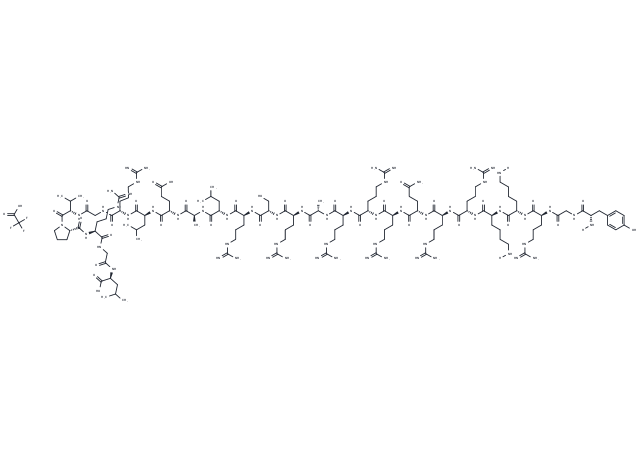 Your shopping cart is currently empty
Your shopping cart is currently empty

Tat-CBD3 is a chemical compound inhibiting the interaction between the N-type voltage-gated calcium channel Cav2.2 and collapsin response mediator protein 2 (CRMP2), as well as the interaction between CRMP2 and the NMDA receptor NR2B subunit. At a concentration of 10 µM, Tat-CBD3 reduces the Cav2.2-CRMP2 interaction by 43% in cell-free assays and impedes the NMDA receptor NR2B subunit-CRMP2 interaction in immunoprecipitation assays. It lowers voltage-induced calcium currents by about 60% in primary rat dorsal root ganglion (DRG) neurons and decreases glutamate-induced cytosolic calcium level rises in primary rat hippocampal neurons. When administered at 20 mg/kg, Tat-CBD3 lessens infarct volume in a rat model of cerebral ischemia following middle cerebral artery occlusion (MCAO). Additionally, intrathecal delivery of Tat-CBD3 at a dose of 20 µg/5 µl mitigates carrageenan-induced thermal hypersensitivity in rats.

| Pack Size | Price | USA Warehouse | Global Warehouse | Quantity |
|---|---|---|---|---|
| 1 mg | $55 | Inquiry | Inquiry | |
| 5 mg | $244 | Inquiry | Inquiry | |
| 10 mg | $428 | Inquiry | Inquiry | |
| 25 mg | $939 | Inquiry | Inquiry |
| Description | Tat-CBD3 is a chemical compound inhibiting the interaction between the N-type voltage-gated calcium channel Cav2.2 and collapsin response mediator protein 2 (CRMP2), as well as the interaction between CRMP2 and the NMDA receptor NR2B subunit. At a concentration of 10 µM, Tat-CBD3 reduces the Cav2.2-CRMP2 interaction by 43% in cell-free assays and impedes the NMDA receptor NR2B subunit-CRMP2 interaction in immunoprecipitation assays. It lowers voltage-induced calcium currents by about 60% in primary rat dorsal root ganglion (DRG) neurons and decreases glutamate-induced cytosolic calcium level rises in primary rat hippocampal neurons. When administered at 20 mg/kg, Tat-CBD3 lessens infarct volume in a rat model of cerebral ischemia following middle cerebral artery occlusion (MCAO). Additionally, intrathecal delivery of Tat-CBD3 at a dose of 20 µg/5 µl mitigates carrageenan-induced thermal hypersensitivity in rats. |
| Molecular Weight | 3192.74 |
| Formula | C134H243N59O32.XCF3COOH |
| Smiles | OC(C(F)(F)F)=O.O=C(NCC(N[C@@H](CCCNC(N)=N)C(N[C@@H](CCCCN[H])C(N[C@@H](CCCCN[H])C(N[C@@H](CCCNC(N)=N)C(N[C@@H](CCCNC(N)=N)C(N[C@@H](CCC(N)=O)C(N[C@@H](CCCNC(N)=N)C(N[C@@H](CCCNC(N)=N)C(N[C@@H](CCCNC(N)=N)C(N[C@H](C(N[C@@H](CCCNC(N)=N)C(N[C@@H](CO)C(N[C@@H](CCCNC(N)=N)C(N[C@H](C(N[C@H](C(N[C@@H](CCC(O)=O)C(N[C@H](C(N[C@@H](CCCNC(N)=N)C(NCC(N[C@@H](C(C)C)C(N1CCC[C@H]1C(N[C@@H](CCCNC(N)=N)C(NCC(N[C@H](C(O)=O)CC(C)C)=O)=O)=O)=O)=O)=O)=O)CC(C)C)=O)=O)C)=O)CC(C)C)=O)=O)=O)=O)C)=O)=O)=O)=O)=O)=O)=O)=O)=O)=O)[C@H](CC2=CC=C(O)C=C2)N[H] |
| Sequence | myristoyl-Tyr-Gly-Arg-Lys-Lys-Arg-Arg-Gln-Arg-Arg-Arg-Ala-Arg-Ser-Arg-Leu-Ala-Glu-Leu-Arg-Gly-Val-Pro-Arg-Gly-Leu-OH |
| Sequence Short | YGRKKRRQRRRARSRLAELRGVPRGL |
| Storage | keep away from moisture | Powder: -20°C for 3 years | In solvent: -80°C for 1 year | Shipping with blue ice/Shipping at ambient temperature. |
| Solubility Information | H2O: Soluble |
| Size | Quantity | Unit Price | Amount | Operation |
|---|

Copyright © 2015-2026 TargetMol Chemicals Inc. All Rights Reserved.